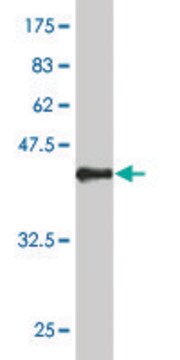AB1854
Anti-Bone Sialoprotein II Antibody
serum, Chemicon®
Sinonimo/i:
BSPII, Integrin-binding Sialoprotein
About This Item
Prodotti consigliati
Origine biologica
rabbit
Livello qualitativo
Forma dell’anticorpo
serum
Tipo di anticorpo
primary antibodies
Clone
polyclonal
Reattività contro le specie
rat, human
Produttore/marchio commerciale
Chemicon®
tecniche
ELISA: suitable
immunocytochemistry: suitable
immunohistochemistry (formalin-fixed, paraffin-embedded sections): suitable
radioimmunoassay: suitable
western blot: suitable
N° accesso NCBI
N° accesso UniProt
Condizioni di spedizione
wet ice
modifica post-traduzionali bersaglio
unmodified
Informazioni sul gene
human ... IBSP(3381)
rat ... Ibsp(24477)
Descrizione generale
Specificità
Applicazioni
Immunohistochemistry (Paraffin) (see suggested protocol below)
Immunocytochemistry (1:100)
RIA
ELISA
Optimal working dilutions must be determined by the end user.
SUGGESTED STAINING PROCEDURE FOR RABBIT ANTI-BONE SIALOPROTEINAB1854
This protocol has been used successfully on 5 um, paraffin embedded sections from human fetal tibia, human fetal calvaria, human metastatic breast tumors to bone which were decalcified in 10% formic acid.
1. Dewaxing: Xylene 5 min. - Xylene 5 min. - Xylene 5 min.
2. Rehydration: 100% ethanol for 3 min. - 95% ethanol for 3 min. - 70% ethanol for 3 min.
3. Wash sections under running tap water for 5 minutes.
4. Wash sections in PBS.
5. Block endogenous peroxidase: 0.3% hydrogen peroxide in absolute methanol (2 mL of H2O2 30% in 198 mL methanol) for 30 minutes. (Cover the jar with foil, use stirring during incubation.)
6. Wash sections under running tap water for 10 minutes.
7. Mark tissue area with pap pen.
8. Cover the tissue area with 300 mL of blocking solution for 30 minutes at room temperature (blocking solution: 6 mL PBS, 0.3 gm BSA, 120 mL normal goat serum).
9. Shake off excess fluid (do not wash).
10. Incubate with primary antibody (AB1854 diluted 1:2,500 in PBS-T) at 2-8°C overnight in moist chamber.
11. Rinse with PBS-T, then wash 3 times in PBS-T each for 5 minutes at room temperature.
12. Incubate with biotinylated secondary antibody (for example Chemicon AP132B) for 30 minutes at room temperature.
13. Rinse with PBS-T, then wash in PBS-T 3 x 5 minutes at room temperature.
14. Incubate the sections with Vector ABC reagent for 30 minutes at room temperature. (ABC reagent: 2 drops of A and 2 drops of B, in 5 mL PBS, allow to stand 30 minutes at room temperature before use.)
15. Wash sections in PBS 3 x 5 minutes at room temperature.
16. Develop with DAB for 5-10 minutes.
17. Wash under running tap water.
18. Counter stain with Mayer′s HX for 45 seconds, wash in warm tap water.
19. Dehydrate: 70% ethanol - 95% ethanol - 100% ethanol, 1 min. each.
20. Wash in Xylene, mount, dry.
Stato fisico
Stoccaggio e stabilità
Note legali
Not finding the right product?
Try our Motore di ricerca dei prodotti.
Codice della classe di stoccaggio
10 - Combustible liquids
Classe di pericolosità dell'acqua (WGK)
WGK 1
Punto d’infiammabilità (°F)
Not applicable
Punto d’infiammabilità (°C)
Not applicable
Certificati d'analisi (COA)
Cerca il Certificati d'analisi (COA) digitando il numero di lotto/batch corrispondente. I numeri di lotto o di batch sono stampati sull'etichetta dei prodotti dopo la parola ‘Lotto’ o ‘Batch’.
Possiedi già questo prodotto?
I documenti relativi ai prodotti acquistati recentemente sono disponibili nell’Archivio dei documenti.
Il team dei nostri ricercatori vanta grande esperienza in tutte le aree della ricerca quali Life Science, scienza dei materiali, sintesi chimica, cromatografia, discipline analitiche, ecc..
Contatta l'Assistenza Tecnica.







